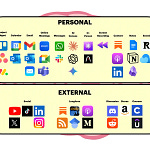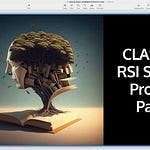Video Source: Bg2 Pod
Imagine walking into your office tomorrow and having 2,000 brilliant minds working for you personally. Not in some distant future—but now. This isn't science fiction. It's exactly what Jensen Huang, founder and CEO of the world's second-largest company, is building at Nvidia.
And almost no one outside of tech understands what's coming.
What Huang revealed in this 70-second clip isn't just another AI update—it's a glimpse into a future that:
Make today's highest performers look like calculator users competing against Excel experts.
Shows what an AI-First company may look like.
Below is a summary of four things that stood out to me from the clip, along with my thoughts on their profound second-order effects:
Nvidia is now using AI at every level of their company
Huang’s vision for the future AI-human workplace is astonishing
Huang plans to have 2,000 AI assistants per employee
Nvidia makes $4M in revenue per employee
#1. Nvidia is using AI at every level of their company
Interviewer: Are you already using Chain of Reasoning and tools like [ChatGPT] o1 in your own business to improve?
Jensen Huang: Our cybersecurity system today can't run without our own agents. We have AI chip designers, AI software engineers, AI verification engineers… They're in every single group.
Third-Order Implication: We are witnessing the birth of AI-first organizations. Just as the internet divided companies into digital-first and digital-laggard organizations, AI is creating a similar divide. But this time, the stakes are much higher.
Think of it like the difference between a native English speaker and someone learning English as a second language. Companies like Nvidia that are building AI into their DNA from the ground up will operate with a fluency and naturalness that traditional companies retrofitting AI will struggle to match.
This isn't just about using AI tools—it's about fundamentally restructuring the organization around AI capabilities. The implications are staggering:
AI becomes the organization's central nervous system, not just a tool
Every process is AI-native rather than AI-enhanced
The organizational structure itself evolves to optimize for human-AI collaboration
#2. Huang’s vision for the future AI-human workplace is astonishing
We'll have a whole directory of AIs that are just generally good at doing things.
Our inbox is going to [be] full of directories of AIs that we work with, that we know are really good, specialized at our skill.
AIs will recruit other AIs to solve problems.
AIs will be in, Slack channels with each other and with humans.
—Jensen Huang
Second-Order Implication #1: Right now, we think of AI as bots with which we chat via text. In the future, they will be more like autonomous entities that we interact with in the same exact way we interact with humans.
Second-Order Implication #2: This suggests the emergence of what we might call "AI social networks" – complex webs of interaction between AI agents and humans. Like biological ecosystems, these networks will develop their own:
Hierarchies: Different AIs specializing in different roles
Communication patterns: New protocols for AI-AI and AI-human interaction
Emergence: Complex behaviors arising from simple interactions
#3. Huang plans to have 2,000 AI assistants per employee
NVIDIA has 32, 000 employees today. I'm hoping that NVIDIA someday will be a 50, 000 employee company with $100M AI assistants.
—Jensen Huang
Second-Order Implication: AI is going to vastly outnumber humans in the workplace. Said differently, AI will eclipse humans in population, cumulative cognition, and communication in the near future.
Third-Order Implication: This represents a fundamental shift in how we think about organizations. It's like the transition from single-cell to multi-cellular organisms—a leap in organizational complexity that enables entirely new capabilities.
Think of it this way: If current organizations are like small towns where everyone knows each other, future organizations will be like vast cities with complex networks of specialized AI agents, each with their own roles, relationships, and responsibilities.
#4. Nvidia makes $4M in revenue per employee (and that’s growing)
Interviewer: NVIDIA is in a league of its own, really, at about $4M of revenue per employee [and] about $2M of profits or free cash flow per employee.
Second-Order Implication #1: Our world seems to be becoming more and more winners take most. AI accentuates this even more. This will create new forms of economic stratification we're only beginning to understand.
Second-Order Implication #2: We're seeing a fundamental shift in how value is created. The traditional notion of human capital is being supplemented—and in some cases replaced—by AI capital.
This is similar to how the Industrial Revolution shifted value creation from human labor to machine capital, but at an intellectual rather than physical level. Companies will be valued not just on their human talent, but on their:
AI Infrastructure: The quality and sophistication of their AI systems
AI Integration: How effectively they combine human and AI capabilities
AI Innovation: Their ability to develop and deploy new AI capabilities
Beyond these shifts in how companies are run, the implications for smart, high-level knowledge workers are just as profound on multiple levels…
🔒 The Great Career Divide: Why Most Knowledge Workers Are Unknowingly Falling Behind (For Paid Subscribers Only)
What Nvidia is doing right now isn't just another corporate AI initiative—it's creating a blueprint for a completely new kind of knowledge worker. One that will make our current definition of "high performer" obsolete.
In this section of the article, I’ll unpack the implications for high-end knowledge workers:
Management skills will matter more than individual intelligence.
Personal intelligence will be measured differently.
AI fluency will create 1,000x advantages.
Learning how to learn with AI will eclipse traditional learning.
Your AI relationship career network may matter more than your human one.










